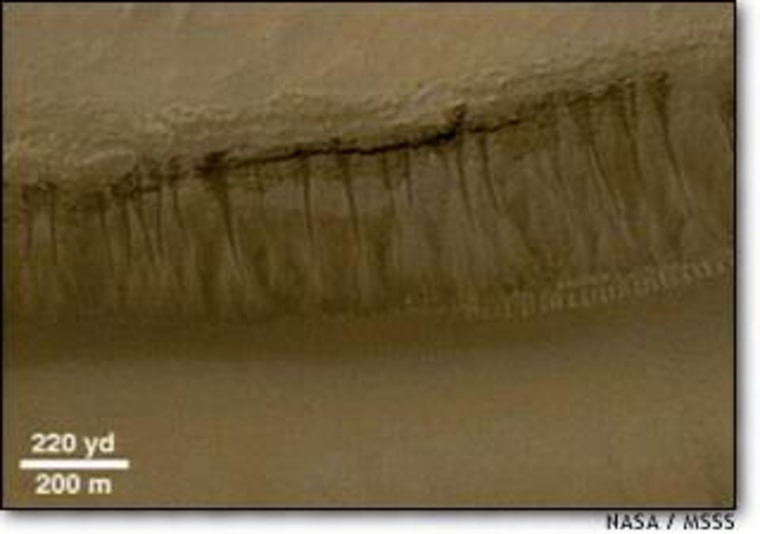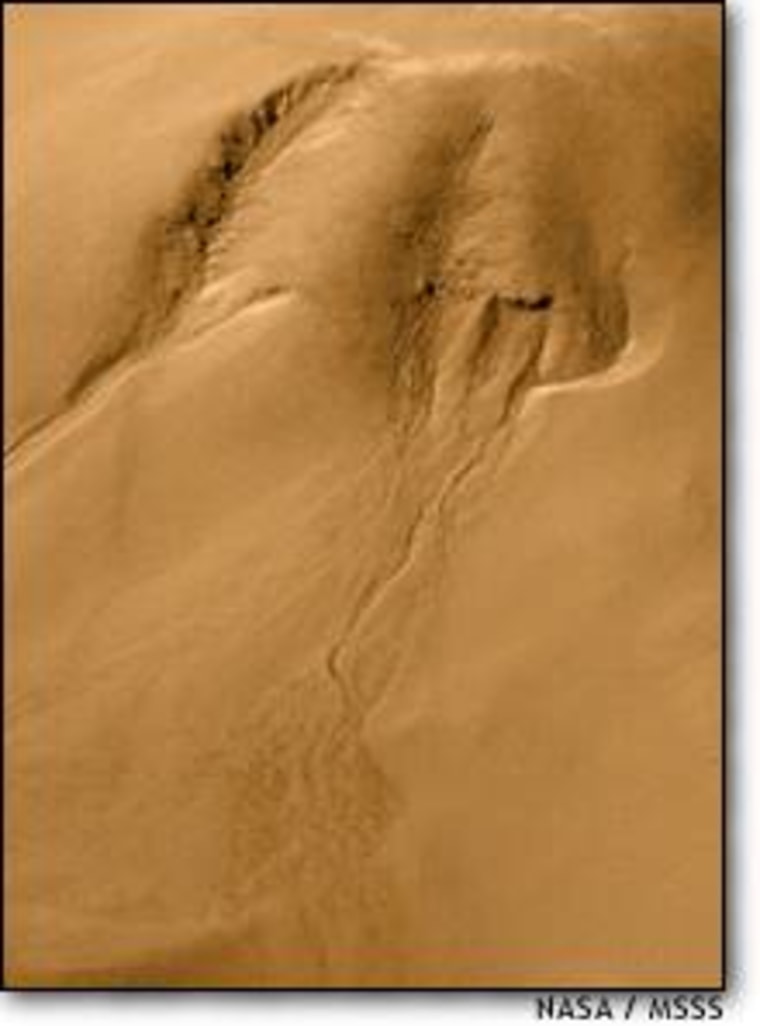New images from NASA’s Mars Global Surveyor probe show fresh gullies and fields of debris, hinting that water flowed over the planet’s surface in recent geologic time, researchers said Thursday. They say the freshness of the features suggests that liquid water may exist not far beneath the surface even today — a claim that, if true, would better the odds of finding life on Mars.
The new findings, released after days of speculation, go against the conventional wisdom on Mars and are likely to re-energize the debate over whether the seemingly dead planet could harbor life.
“If these results prove true, that there is water on Mars near the surface, it has profound implications for the possibility of life on Mars,” said Ed Weiler, NASA’s associate administrator for space science.
But experts cautioned that there could be alternate explanations for the features seen in Global Surveyor’s images. Even the researchers behind the study, Michael Malin and Kenneth Edgett of Malin Space Science Systems, said they were confounded by what they saw.
“We were quite surprised and confused by it, because in fact it doesn’t really fit our models of what Mars is like,” said Malin, whose San Diego-based company operates Global Surveyor’s camera on NASA’s behalf. A selection of images was made available via Malin’s Web site.
NASA had planned to announce the results June 29 to coincide with the study’s formal publication in the June 30 issue of the journal Science, but the announcement was moved up a week due to intense media interest and a growing torrent of reports leaked to journalists. During a Thursday briefing at NASA Headquarters in Washington, the panelists said apologetically that there was not enough time to finish the whizbang graphics they had planned to use to illustrate their talks. Nevertheless, the unadorned images spoke for themselves.
Underground springs
The images, taken from Global Surveyor’s mapping orbit about 230 miles (370 kilometers) above the surface, clearly show dry V-shaped gullies trickling down the sides of craters, with fans of debris spread below. Since the areas were unmarked by craters, Malin and Edgett concluded that the gullies were created recently in geological terms — perhaps hundreds or thousands or millions of years ago, or even days ago, rather than billions of years ago.
Malin said the absence of craters means scientists can’t determine how old most of the features are, “because the thing that we would measure to say they’re old doesn’t exist.”
Some of the features show sharp variations in light and dark material, indicating that not enough time has passed for Martian dust to settle uniformly over the scene, Edgett said.
“That really bothers me,” he said. “I was dragged kicking and screaming to this conclusion.”
For years, scientists have documented ample evidence that liquid water flowed over Mars billions of years ago, when the planet presumably was warmer and more Earthlike. But the new images provide the first hard data hinting at a more recent flow.
Of course, water has long been known to exist in frozen form at Mars’ north pole, along with frozen carbon dioxide. And there are traces of water vapor in the thin Martian atmosphere. However, scientists say liquid water cannot exist for long at the Martian surface, because of low temperatures and low atmospheric pressure — just as conditions on Earth aren’t conducive for carbon dioxide to exist in liquid form. It should either freeze or boil off immediately.
Scientists thought the Martian crust was so cold you’d have to go down two to four miles (three to six kilometers) to hit liquid water. But Malin and Edgett say the Global Surveyor images indicate that underground aquifers may lie within 1,640 feet (500 meters) of the surface — and that the water periodically breaks out from the walls of craters.
However, none of the images has captured such a breakout. And Malin said the features indicative of water flow have been spotted on only 250 of the 65,000 images taken since Global Surveyor arrived in Martian orbit in September 1997.
The researchers said the features were too small to have been detected by previous Mars probes, such as Mariner or Viking. But Mars Global Surveyor’s orbital camera can provide views of unparalleled resolution, ranging down to 4.6 feet (1.4 meters) per picture element.
How it could happen
Here’s how Malin and Edgett believe the features were created: Within Mars’ crust, the crushing pressure keeps trickles of water liquid as they percolate up toward the surface. Eventually, some water seeps through a crater wall, freezing into an ice dam. The water pressure behind that ice builds up to the point that the dam bursts, releasing a flash flood that rushes downhill. The liquid dissipates soon after emerging onto the surface, leaving a dry, eroded gully behind.
The researchers noted that the features are usually found on slopes facing away from midday sunlight, at latitudes between 30 and 70 degrees in both Martian hemispheres.
“The relationship to sunlight and latitude may indicate that ice plays a role in protecting the liquid water from evaporation until enough pressure builds for it to be released catastrophically down a slope,” they said in a statement.
Michael Carr, an expert on Mars at the U.S. Geological Survey, said he found the interpretation that the features were caused by liquid water “very compelling,” but he cautioned that there could be alternate scenarios. For example, a combination of water and carbon dioxide molecules known as a clathrate could cause “a gas-lubricated flow somewhat similar to a lubricated flow on Earth.”
“Perhaps there are processes on Mars that do not occur on the earth. ... The important thing is to be cautious about the interpretation but to get the information out to the science community,” Carr said.

Life on Mars?
The detection of liquid water — even by indirect means — would raise hopes for finding traces of organisms on Mars, since biologists consider liquid water one of the three prime requirements for harboring life. The other two requirements are the presence of life’s organic building blocks and an energy source, such as sunlight or hydrothermal energy.
“While this clearly doesn’t tell us anything about whether life does exist at present or ever has in the past, I think it’s the smoking gun that says there’s liquid water, and Mars meets all of the environmental requirements to support life,” said Bruce Jakosky, a planetary scientist at the University of Colorado at Boulder.
A future robotic rover or a human crew could touch down at a site where water may be close to the surface and drill down for samples under stringent conditions aimed at preventing contamination. Samples of ice or water could be analyzed for indicators of prebiotic chemical activity, organic activity, or even the presence of the microbes themselves.
The availability of water could have an impact on Mars’ future as well as our understanding of its past: Human settlers could use it not only for drinking, but for manufacturing hydrogen-based fuel and oxygen.
But Weiler cautioned that there was plenty of “homework” to be done before such missions come off the drawing boards. He said targeting the type of dry gully discussed Thursday would require the ability to land a probe within feet or inches of a target; currently, the margins of error are measured in miles or kilometers.
The past year has demonstrated how difficult it is to explore Mars: Last September, NASA lost a $125 million Mars orbiter due to navigational errors. Last December, a $165 million lander in December disappeared without a trace, most likely falling prey to an engineering flaw. Two microprobes that were attached to the lander’s spacecraft — a mission valued at $29.2 million — also yielded nothing but disappointment.
The multiple failures led NASA to cancel plans to send another lander to Mars next year, although a 2001 orbiter will be launched as scheduled. Weiler said the space agency would decide within weeks whether to launch an orbiter or a Pathfinder-style lander toward Mars in 2003, and its long-range plan for Mars exploration beyond 2003 is due to be completed this fall.
Weiler said the research revealed Thursday “increases the ante to understand Mars as a planet.” He noted that the findings fit perfectly with NASA’s stated aim to “follow the water” in order to look for life beyond Earth, and to do extensive robotic reconnaissance in preparation for Mars landings.
Weiler acknowledged that Thursday’s news was a welcome turnaround for NASA’s space science efforts.
“It is very, very pleasing to be up here on this dais and talking about something positive for a change,” he said. “We’ve had some failures at Mars, but we’ve learned from our failures. That’s the important thing.”
